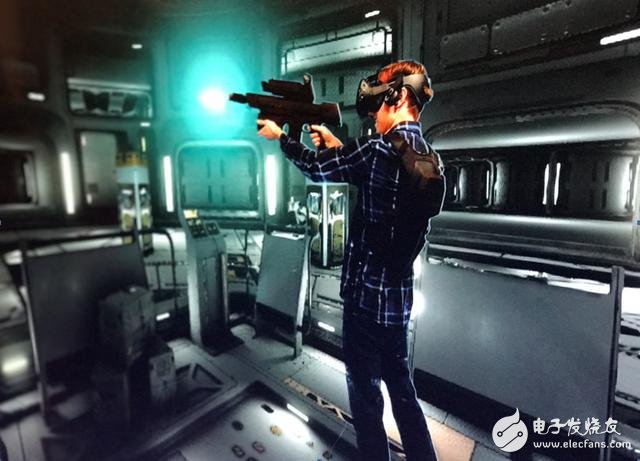Companies that simply use VR display devices as a selling point will have few left. This is not an alarmist. Motion capture technology company Novo Teng co-founder & CTO Dai Ruoli told the author that the entire VR field has completed a round of reshuffle, some low-end players who entered the market early, gradually out, talents and funds to valuable, direction-oriented companies Gather together.
From the beginning of the VR outbreak to the time of adjustment, the time has passed less than a year. In addition to Google's "cardboard", which is considered an early prototype, the three main players in the VR head-end device market are Sony's PlayStaTIon VR (hereafter referred to as PSVR), HTC Vive and Facebook's Oculus. In addition, Samsung has worked with Oculus to create Gear VR products.
According to the analyst firm Canalys, in 2016, global VR head-to-head shipments are expected to exceed 2 million units, of which PSVR ships more than 800,000 units, HTC Vive ships about 500,000 units, and Oculus Rift ships 400,000 units. station. The total shipments of these three companies have accounted for 85% of the total market.
But shipments are only one dimension of this market evaluation. From the perspectives of technology or cost performance, the market position of the above three companies, analysts and market views and shipping rankings are not the same. Dai Ruoli said that from a commercial point of view, Sony is more successful with the user base of the game console, but HTC's technology is leading from the perspective of examining the accuracy and delay performance of equipment performance.
The performance in the regional market is also different. Canalys analyst Jason Low expects that 60% of HTC Vive's products will flow to the Chinese market. Min Ming, founder of ant vision technology, told the author that there are two main reasons for HTC's sales in China. One is because Oculus has not entered this market, and HTC's solution is currently the most mature VR device in China.
In fact, the giants have begun to assemble the market and set industry standards.
“The cost of VR products has stabilized and the industry will expand toward accessories and content,†said Wang Congqing, president of HTC Vive China, in an exclusive interview with the author. “The use of HTC accessories by third parties can save 6 months of development and time to market, and let the experience More abundant."
On January 4th, local time, HTC released Vive's new Vive tracker at the Consumer Electronics Show (CES), which can be paired with compatible devices to make it a VR device. The basic principle is the same as that of the HTC Vive, and the spatial coordinates are determined by multiple points. The tracker can even be seen as a simplified version of the handle, which is a complete structure of a circular table supported by three fulcrums.
During CES, HTC provided eight third-party integration cases, such as combining digital SLR cameras to create mixed-reality video; and combining with toy guns to give users a better experience in shooting games. Among them, Nuo is the first consumer-grade product action capture glove with a Vive tracker, in order to obtain accurate spatial positioning information.

Figure: Players get a new gaming experience with the tracker
Not only that, but the giants also began to integrate content, and the exclusive application stores continued to provide services. With the advantages of the game console, Sony has a large number of content development partners. At the 2016 E3 Game Show, Sony announced that it will have more than 50 games sold with PSVR. HTC's convenience means that its content providers will double in 2017 and will be funded to reward developers.
At the same time, at the end of 2016, companies such as HTC, Facebook, Sony, Google, Samsung and Acer established a non-profit organization, the Global Virtual Reality Association (GVRA), which hopes to develop industry standards, share technical practices, and conduct product surveys.
However, there are also views that VR devices will still be dominated by chip and system companies. Dai Ruoli said that it seems that Google's native VR platform Daydream, Samsung's Amoled screen and other components, as well as Qualcomm and Intel's chips will become the common standard in the VR industry, each VR company will be mainly responsible for industrial design and system integration.
At present, for startups other than three, differentiation will give them a certain market space. Min Min said that unlike HTC and other giants, AntVision will focus on Internet cafes, education, medical and other fields. These industries are characterized by high demand for product usage and low purchase price.
In terms of technology, there is also a certain space for development. The new product of Ant Technology will shorten the optical focal length to one-third of the original, making the weight of the entire VR product lighter. Min Min expects to be able to reach mass production in 2017.
Jason Low said that some of the giant's products will be delayed until full supply in 2017, leaving a huge room for growth. The VR market still has several years of upside. Canalys expects that global VR head-to-head shipments in 2020 will be 10 times that of 2016, reaching 20 million units.
ATS48 offers reliable, robust and high performance Soft Starters for your motors with unique Torque Control Systems (TCS).
3 Phase For Motor Control Inverter,Mini Inverter ,Inverter Circuit Board ,Schneider Inverter Charger
Wuxi Trenty Machinery & Equipment Co., Ltd. , https://www.elec-inverter.com